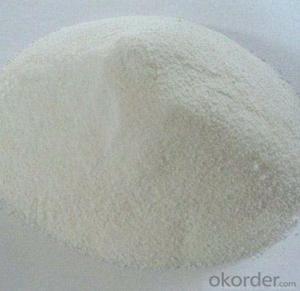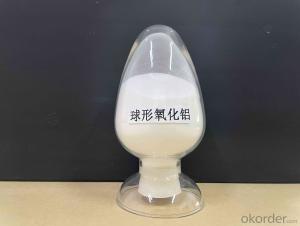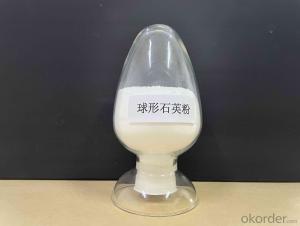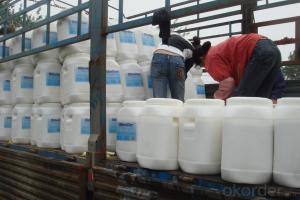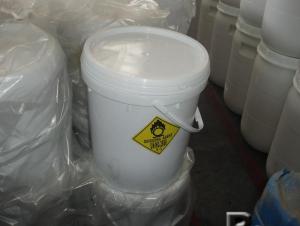Plastic Additives Impact modifier(A C R),for Plastic Tubes Reforcement
- Loading Port:
- Qingdao
- Payment Terms:
- TT or LC
- Min Order Qty:
- 5000 kg
- Supply Capability:
- 100000 kg/month
OKorder Service Pledge
OKorder Financial Service
You Might Also Like
1. Structure of Plastic Additives Impact modifier
Classification:Chemical Auxiliary Agent
CAS No.:63231-66-3
Other Names:chlorinated polyethylene
Appearance:White Powder
Chlorine Content:35%
Volatiles Content:0.3%
Tearing Strength:8.0Mpa
Elogation at Break:800%
2. Main Features of ACR
Package Details:25kg/bags, Paper and plastic bags,
Delivery Date: 7 Days
Chlorine Content:35%
Volatiles Content:0.3%
3.Specification
Item | Unit | Index | |
Chlorine content | % | 35±1 | |
Thermal decomposition temperature | ≥ 165 | ||
Volatile Matter content | % | ≤0.3 | |
Remains crystallinity | % | ≤ 5 | |
Tearing Strength | Mpa | ≥8.0 | |
Rate of filtration | 36mesh | % | ≥99 |
Shore Hardness A | ° | ≤57 | |
Apparent Density | g/ml | ≥0.55 | |
Impurity Particle | PC/ 10g | 10 | |
WhitenessR457 | ° | ≥86 | |
| Elogation at break | % | 800 | |
4.Images
PVC Impact Modifier is Mainly used for producing PVC profiles, U-PVC waterpipe & sewer pipe, cold curved pipe line, PVC blowing board and PVC extrusion board
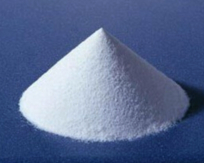

5.FAQ
1. Why Choose us?
CNBM is a stated own company, provide the guarantee for the best quality, best service and safety business.
2. How will we guarantee the quality?
a, ISO 9001-2008 quality control system;
b, Strict and regular quality control in production;
c, Inspeciation when loading into container before shippment;
d, Sample stock for one year for quality tracing and record.
3. What is your MOQ?
Our MOQ is one pallet.
4. Can you provide sample?
Yes, samples are in stock. we can offer free sample for you.
5. Payment terms?
We can accept L/C, T/T etc.
6. Do you offer OEM service?
Yes, we can print customers’ logo on the packaging;
And the size and specification can be produced and design according to your demand.
- Q:An important property of the catalyst is that the reaction equilibrium is not changed while increasing the forward reaction rate and the reverse reaction rate. However, because the enzyme for the specificity of the substrate, is not almost every reaction by the enzyme are one way to do it.
- Enzymes, refers to the biocatalytic function of the polymer material, in the enzyme catalytic reaction system, the reactant molecules known as the substrate, the substrate catalyzed by the enzyme into another molecule. Similar to other non-biocatalysts, the enzyme changes the reaction rate by adjusting the Gibbs free energy of the chemical reaction, and most of the enzyme can increase the rate of its catalytic reaction by a million times; in fact, the enzyme is provided with another The activation energy requires a lower route so that more reactive particles produce more effective collisions to produce more kinetic energy. According to the first law of thermodynamics, the kinetic energy obtained by the collision can accelerate the reaction rate by transformation. The enzyme as a catalyst itself is not consumed in the reaction process nor does it affect the chemical equilibrium of the reaction.
- Q:Effect of Catalyst on Chemical Reaction Rate
- The catalyst can reduce the activation energy of the chemical reaction and allow the reaction to take a shortcut
- Q:How does the chemical equation calculate the quality of the catalyst?
- So the reactant mass is equal to the quality of the product, with the quality of conservation
- Q:What is the microcosmic principle of the catalytic reaction in the chemical reaction?
- It is actually directly involved in the reaction, but, after the reaction, it has become a product out, the equivalent of no response
- Q:I know that a species that does not appear in the chemical equation may also affect the rate of a reaction - e.g. a catalyst. But does that mean the catalyst can be present in the rate equation, and if so are catalysts always present in the rate equation?
- All the factors that affect a reaction rate, except for concentration and reaction order, are taken into account in the rate equation of the reaction. A catalyst: The presence of a catalyst increases the reaction rate (in both the forward and reverse reactions) by providing an alternative pathway with a lower activation energy. en.wikipedia.org/wiki/Reaction_ra...
- Q:What is the difference between a catalyst and an inducer in a chemical reaction?
- The catalyst does not participate in the reaction, but only the carrier of the reaction; the inducer will participate in the reaction
- Q:What is the principle of the catalyst? Why can change the rate of chemical reactions and their own without any change
- The principle of the catalyst: the catalyst is mainly by reducing the activation energy, so that the reaction is easy to carry out, so as to achieve the catalytic effect.
- Q:What is the difference between biological enzymes and chemical catalysts?
- Biological enzymes are an environmentally friendly biocatalyst with greater superiority. Such as the reaction speed, processing conditions (such as temperature, PH value, etc.) more moderate, safe and easy to control the operation and can replace the strong alkali and other chemicals. The biological enzymes act only on specific substrates, with little damage to the substrate and the biodegradation of the treated wastewater to reduce water and energy consumption. After more than a century of research by scientists, more than 3,000 known enzymes are generally considered. The application of biological enzymes in the textile industry, initially the application of α-amylase in cotton fabric desizing process, and later developed into the cellulase used in denim washing and bio-polishing process, and now the development of pectinase to the biological scouring Technology, hydrogen peroxide enzyme catalytic decomposition technology, protease in silk and wool fiber applications
- Q:Exemplify the use of green catalysts in green chemistry
- How can a green catalyst, they do not react
- Q:What is catalyst in Science?
- A catalyst is a substance that increases the rate of a reaction by decreasing the activation energy (energy required to start the reaction). It does so by creating a new reaction mechanism (the way the reaction happens on a molecular level) that happens more easily and with less energy. For example, a catalyst could attract both reactants, thus bringing them directly together and facilitating the reaction.
1. Manufacturer Overview |
|
|---|---|
| Location | |
| Year Established | |
| Annual Output Value | |
| Main Markets | |
| Company Certifications | |
2. Manufacturer Certificates |
|
|---|---|
| a) Certification Name | |
| Range | |
| Reference | |
| Validity Period | |
3. Manufacturer Capability |
|
|---|---|
| a)Trade Capacity | |
| Nearest Port | |
| Export Percentage | |
| No.of Employees in Trade Department | |
| Language Spoken: | |
| b)Factory Information | |
| Factory Size: | |
| No. of Production Lines | |
| Contract Manufacturing | |
| Product Price Range | |
Send your message to us
Plastic Additives Impact modifier(A C R),for Plastic Tubes Reforcement
- Loading Port:
- Qingdao
- Payment Terms:
- TT or LC
- Min Order Qty:
- 5000 kg
- Supply Capability:
- 100000 kg/month
OKorder Service Pledge
OKorder Financial Service
Similar products
New products
Hot products
Related keywords
